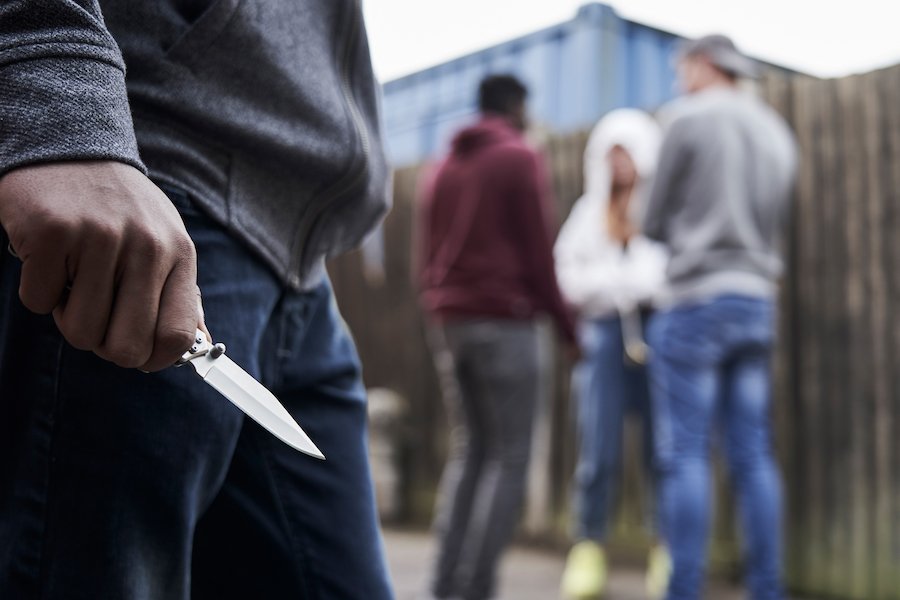Colorado law does not enhance criminal sentences for gang-related crimes. However, the criminal nature of gangs makes members vulnerable to racketeering and other charges. Using a dangerous weapon during crimes of violence will enhance criminal sentences by five years. And when defendants are being sentenced, the court may consider relevant evidence of their past or present gang affiliations.
In this article, our Denver Colorado criminal defense attorneys discuss:
- 1. What are gangs?
- 2. Are gang crimes penalized more harshly in Colorado?
- 3. What are common gang crimes and their penalties?
- 4. How do you defend against gang crimes?
- 5. What are the gangs in Colorado?

There is no gang enhancement for Colorado criminal sentences.
1. What are gangs?
Colorado criminal street gangs are ongoing organizations of three-plus people whose intent is to commit serious crimes, and they engage in a “pattern of criminal gang activity.” A pattern of criminal gang activity means:
[T]he commission, attempt, conspiracy, or solicitation of two or more predicate criminal acts which are committed on separate occasions or by two or more persons.
These predicate criminal acts consist of either:
- any conduct defined as racketeering activity in CRS 18-17-103 (5); and/or
- retaliation against a witness or crime victim in violation of CRS 18-8-706.1
Gangs typically include young people in their twenties and teens. Common examples of gang-related criminal conduct include criminal mischief (CRS 18-4-501), assault, vandalism, defacing property, illegal discharge of a firearm (CRS 18-12-107.5), and other property and violent crimes. Some gangs center around such criminal enterprises as drug trafficking and money laundering.
2. Are gang crimes penalized more harshly in Colorado?
There is no statutory sentencing enhancement for Colorado crimes committed in pursuit of gang-related activities. Therefore, gang members and non-gang members face the same sentencing range under state law for committing the same criminal offense.
However, a defendant’s gang affiliation can come in as evidence during a sentencing hearing if it is related to the nature of the offense and the defendant’s character.
Example: As part of his youth gang initiation, Maurice robs a pedestrian at gunpoint. Maurice is convicted of robbery. During his sentencing hearing, the judge admits evidence of Maurice’s gang involvement because it “sheds light on his tendency toward aggression, rage, and assaultive behavior.” And this evidence may influence the judge’s sentencing decision.
In short, a defendant’s gang membership cannot be the main reason why a judge imposes a particular sentence. But it can be a factor as long as it is relevant to the case and the defendant’s character.2
3. What are common gang crimes and their penalties?
|
Gang crime |
Colorado penalties |
| Racketeering (CRS 18-17-104) | Class 2 felony:
The mandatory parole period is 3 years or 5 years, depending on whether it involved a crime of violence. |
| Witness retaliation (CRS 18-8-706) | Class 3 felony :
The mandatory parole period is 3 years. |
| Second-degree assault (CRS 18-3-203) as a crime of violence | Class 4 felony:
The mandatory parole period is 3 years. |
| Illegal discharge of a firearm (CRS 18-12-107.5) | Class 5 felony:
The mandatory parole period is 2 years. |
| Criminal mischief (CRS 18-4-501) of $1,000 to less than $5,000 | Class 6 felony:
The mandatory parole period is 1 year. |
| Aggravated robbery (CRS 18-4-302) |
The mandatory parole period is 3 years. |
| Third-degree arson (CRS 18-4-104) | Class 4 felony:
The mandatory parole period is 3 years. |
Note that recruiting a juvenile under 18 years of age for a criminal street gang (CRS 18-23-102) is a misdemeanor offense in Colorado. Penalties include up to 364 days in jail and/or fines of up to $1,000.
Also, note that committing a crime of violence with a dangerous or deadly weapon – such as a gun or knife – adds a five-year sentence enhancement to the prison term.3
4. How do you defend against gang crimes?
The best defenses turn on the specific charges and available evidence. In general, five effective defenses to gang-related crimes include the following:
- Mistaken identity. Many gang members dress alike, so perhaps the police officers mistook the innocent defendant for the real culprit.
- False accusations. It is not uncommon for people to falsely accuse others – particularly rival gang members – out of anger or revenge.
- No criminal activity. Just because one gang member committed a crime does not mean that the other members are guilty by association. As long as the defendant had no hand in planning or executing the crime, criminal charges should not stand.
- Illegal search. If a law enforcement agency conducted an unlawful search, then the defense attorney can ask the court to disregard any evidence found through the search. If the judge agrees, the prosecution’s case may be too weak to continue.
- Entrapment. Police department officers are allowed to go undercover and trick people who are already predisposed to breaking the law into committing a crime. But if the defendant would not have committed the crime but for the police’s pressure, then the charge could be dismissed on entrapment grounds.
In any criminal case, prosecutors bear the burden of proving guilt beyond a reasonable doubt. Common evidence includes eyewitness testimony, medical records, surveillance video, GPS records, and expert forensic testimony. The case should be dismissed if the district attorney has insufficient evidence to sustain a conviction.
5. What are the gangs in Colorado?
The national gang the Crips is one of the larger gangs in Denver. Its subsets include:
- Tre Tre Crips
- Tre 31st
- Tre Duce
- Tre Tre Finest
Other gangs include the Rollin’ 30s, the Bloods, Gallant Knights Insane, 303 Mafia, North Side Mafia, Inca Boyz, 18th Street gang, and 211 Crew.
Colorado’s gang activity is typically centered in Federal Heights, Aurora, Englewood, Commerce City, East Denver, Thornton, 5 Points, Lakewood, Sheridan, Mountain View, Twin Lakes, Sherrelwood, and North-East Park Hill.

Call our criminal justice system law firm for legal advice. We offer free consultations.
Arrested for a misdemeanor or felony offense involving gang violence or other crimes? We appear in state and federal law courts throughout Colorado.
See our related articles on contributing to the delinquency of a minor (CRS 18-6-701), drug use (CRS 18-18-404), extortion (CRS 18-3-207), and domestic violence.
In California? See our article on gang enhancements (PC 186.22)
In Nevada? See our article on gang enhancements (NRS 193.168).
Legal References
- Colorado Revised Statute (criminal code) 18-23-101.
- People v. Tresco, (Colorado Court of Appeals, Division A 2019) COA 61, 457 P.3d 112; Dawson v. Delaware, (1992) 503 U.S. 159, 112 S. Ct. 1093.
- CRS 18-1.3-406(7). Prior to March 1, 2022, recruiting a juvenile for a gang was always a class 1 misdemeanor. Now it can be a class 1- or class 2 misdemeanor depending on the case. SB21-271.
